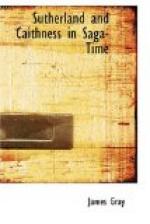From the above account of the matter, it appears that Earl John, who was responsible for law and order in Caithness at the time, although invited by Rafn the Lawman to intervene, and although he was on the spot, did nothing, saying “he could give no advice” and “that he thought it concerned him very little,” and adding that “two bad things were before them, that it was unbearable” and that “he could suggest no other choice,"[10] that is, but to pay the bishop’s tithes, however exorbitant, or not pay them, or possibly to make an end of him. It is clear also that the monk who was with the bishop was to blame for his exactions. But there is some excuse in the fact that Bishop John had been censured by Rome for his neglect in collecting the dues of Rome or Peter’s Pence as greatly as Bishop Adam was blamed by the people of Caithness for his greediness. There is no need to brand Bishop Adam as a voluptuary for excessive drinking and immorality.[11]
These events took place in 1222, and King Alexander, urged by the remainder of the bishops in Scotland, at once marched into Caithness with an army, and took vengeance on the bishop’s murderers by mutilating a large number of those concerned and seizing their lands,[12] while in 1223 the Pope excommunicated them and also interdicted them from their lands.
The Annals of Dunstable, however, paint Earl John in much blacker colours, and state that he himself caused the bishop, who was escaping from the fire, to be cast into it again, and the bodies of two others previously slain, his nephew and the monk, to be thrown upon him, and that King Alexander forfeited half John’s earldom.[13]
The Saga says that the king forfeited Earl John’s lands for the murder of the bishop. Wyntoun, however, states that afterwards, at Christmas festivities at Forfar,
“Thare borwyd that erle than his
land
That lay unto the Kyngis hand
Fra that the byschape of Cateness,
As yhe before herd, peryst wes."[14]
By this “borrowing,” however, Earl John recovered only the reduced earldom above described, that is without the Lordship of Sutherland, to which William de Moravia, Hugo’s son, had succeeded between 1211 and 1214, and without that south-western portion of it, which, as stated, had been given to Gilbert de Moravia by Hugo in 1211, and without the Moddan family’s lands near Loch Coire and in Strathnaver and Caithness, and without Harald Ungi’s moiety or half share of the Caithness earldom; and, as already stated, the lands appertaining to this share were probably occupied by his family as represented by Gunni and Ragnhild, Eric Stagbrellir’s youngest daughter, and by the members of the Moddan clan, and the retainers of the Erlend line.
In 1223, Earl John was again at Bergen, with Bishop Bjarni of Orkney and others, to consider the rival claims of King Hakon and Jarl Skuli to the Norse crown,[15] and in 1224 he went thither again to leave his only son, Harald, as a hostage for his own loyalty.[16] In 1226, Harald was drowned at sea, probably on his return voyage, thus leaving John without any male heir, and save for his nameless hostage daughter or her children, if any, without any direct lineal heirs for the jarldom and earldom of Orkney and of Caithness respectively.




